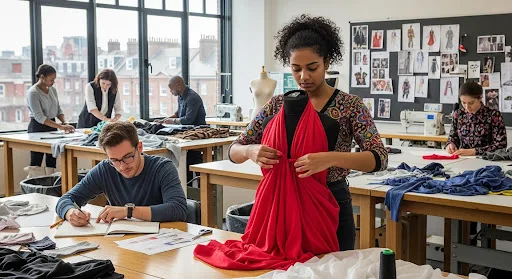Introduction
Graphic design plays a central role in shaping modern communication, branding, and digital experiences. In the UK, the demand for skilled designers continues to rise, with businesses seeking creative professionals who can deliver visually compelling content across print and digital platforms. Enrolling in graphic design courses in the UK is one of the most effective ways to acquire essential skills, gain industry recognition, and build a portfolio that opens doors to rewarding opportunities. This article explores the types of graphic design courses available, the skills you will learn, career pathways, and how to choose the right programme to transform your creative ambitions into a profession.
Why Study Graphic Design in the UK?
A Thriving Creative Industry
According to the UK’s Department for Digital, Culture, Media & Sport (DCMS), the creative industries contribute more than £100 billion annually to the UK economy. Graphic design, as part of this sector, offers countless opportunities for talented professionals.
Benefits of Formal Courses
- Technical Mastery: Gain expertise in design software such as Adobe Creative Cloud.
- Creative Development: Learn to apply design principles across branding, advertising, and digital platforms.
- Professional Recognition: Accredited qualifications improve employability.
- Networking: Connect with industry professionals and peers.
- Portfolio Building: Graduate with a strong body of work that showcases your skills.
Types of Graphic Design Courses in the UK
University Degrees in Graphic Design
Leading universities, including the University of the Arts London (UAL) and Glasgow School of Art, offer BA and MA programmes.
- Duration: BA (3–4 years), MA (1–2 years).
- Focus: Academic study, creative experimentation, and real-world projects.
- Best for: Students aiming for a comprehensive education and long-term career prospects.
HND and Foundation Courses
Colleges across the UK provide Higher National Diplomas (HNDs) and foundation courses in design.
- Duration: 1–2 years.
- Focus: Practical skills and industry-relevant training.
- Best for: Learners seeking a faster entry into the workforce.
Professional Short Courses
Institutions like Shillington Education and London College of Communication offer intensive courses designed for working professionals.
- Duration: 3–12 months.
- Focus: Practical skills, portfolio development, and applied design.
- Best for: Career changers and professionals upgrading skills.
Online Courses
Platforms such as FutureLearn and Coursera provide flexible online programmes.
- Duration: Flexible, self-paced.
- Focus: Software mastery, typography, branding, UX design.
- Best for: Learners balancing study with work commitments.
What You Will Learn in Graphic Design Courses
Core Skills
- Design Principles: Colour theory, typography, and composition.
- Digital Tools: Adobe Illustrator, Photoshop, InDesign, and Figma.
- Brand Identity: Creating logos, brand guidelines, and visual systems.
- UX and UI Design: Designing intuitive and user-centred digital interfaces.
- Print and Digital Media: Designing across platforms, from posters to websites.
Professional Development
- Portfolio Creation: A key component for securing roles and clients.
- Industry Collaboration: Many courses involve real-world briefs from companies.
- Career Preparation: Learn freelancing, pricing, and client management.
Costs of Graphic Design Courses in the UK
| Course Type | Average Cost (GBP) | Duration |
|---|---|---|
| University Degree | £9,250 per year | 3–4 years |
| Master’s Programme | £10,000–£20,000 | 1–2 years |
| HND/Foundation Course | £4,000–£8,000 | 1–2 years |
| Professional Short Course | £3,000–£12,000 | 3–12 months |
| Online Course | £50–£500 | Flexible |
(Updated costs available on gov.uk student finance)
Career Opportunities After Graphic Design Courses
Employment Options
- Graphic Designer: Working in agencies, media, or corporate teams.
- Branding Specialist: Creating and maintaining brand identities.
- Digital Designer: Designing websites, apps, and digital campaigns.
- Freelance Designer: Building an independent client base.
- Creative Director: Leading teams in agencies or in-house studios.
Salary Expectations
According to Prospects.ac.uk, entry-level graphic designers in the UK earn between £20,000–£25,000 annually, with senior designers and creative directors exceeding £50,000–£70,000 depending on industry and experience.
Choosing the Right Graphic Design Course
Key Considerations
- Accreditation: Ensure the course is recognised by professional bodies like the Chartered Society of Designers (CSD).
- Portfolio Support: Choose programmes that prioritise portfolio development.
- Flexibility: Decide between full-time, part-time, or online formats.
- Specialisation: Identify whether the course focuses on branding, digital, or print.
- Budget: Balance costs against long-term career goals.
Pros and Cons of Different Options
- University Degrees
- Pros: Comprehensive, respected, broad career opportunities.
- Cons: Expensive, time-intensive.
- HND/Foundation Courses
- Pros: Affordable, practical.
- Cons: Less theoretical depth.
- Short Courses
- Pros: Fast, industry-focused.
- Cons: Limited coverage of broader design theory.
- Online Courses
- Pros: Flexible, affordable, accessible worldwide.
- Cons: Limited networking opportunities.
Conclusion
Graphic design courses in the UK offer a wide range of opportunities for creative professionals at all levels. Whether you choose a university degree, a short professional course, or an online option, each pathway provides valuable skills, industry connections, and portfolio development opportunities. The UK’s thriving creative industries make it an ideal environment for aspiring designers to flourish. By investing in the right training, you can transform your passion into a rewarding career, learning directly from some of the best professionals in the field.
Frequently Asked Questions (FAQ)
1. Do I need a degree to work as a graphic designer in the UK?
No, while degrees help, many designers build successful careers through short courses, online training, and strong portfolios.
2. How long does it take to become a professional graphic designer?
It depends on the course. University degrees take 3–4 years, while intensive courses may take just a few months.
3. Are online graphic design courses credible?
Yes, if taken through recognised providers such as FutureLearn, Coursera, or universities. Accreditation and portfolio building are key.
4. What software should I learn first as a beginner?
Adobe Photoshop and Illustrator are standard industry tools, but Figma and InDesign are also essential for digital and print design.
5. Can I freelance after completing a graphic design course?
Absolutely. Many graduates start freelancing immediately, using their portfolios to attract clients while building industry experience.


 The Foundations: What Your Portfolio Must Include
The Foundations: What Your Portfolio Must Include  Photography Courses in the UK: How to Become a Professional
Photography Courses in the UK: How to Become a Professional  Fashion and Style Training: Fashion Design Courses in the UK
Fashion and Style Training: Fashion Design Courses in the UK